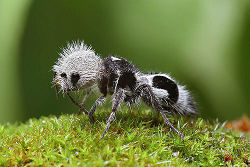Panda ant
| Panda ant |
|---|

|
| Scientific Classification |
|
| Scientific Name |
|
Euspinolia militaris |

|
| Panda Ant changes colors to warn predators |
Welcome to the world of the Panda Ant. Is it a panda or is it an ant? It's neither and it comes from the Mutillidae Family. These are actually wasps.
It has a body design very similar to a wasp. It's body changes color to warn predators, but it's name comes from the colors being black and white like a Panda Bear.
It's a warm climate insect and the preferred area of living is warm and dry, like the desert.
Even though it can lay up to 2,000 eggs, this species is near extinction!
Body Design
The Panda Ant isn't an ant, it's actually a wasp. Just like an ant it has six legs, and the females have no wings (the diagram shows wings because this is a wasp) The Ant has a white head, and long thin hairs around his body, which might explain why they are sometimes called Velvet Ants. The thorax is black with a white square in the center. The abdomen has two black dots by its black legs, and lines going through them to the anus. They have a tough exoskeleton that helps keep their body moisture due to their living conditions and the exoskeleton also helps when they go hunting for prey. Their stingers are right by their mouth, and their stingers are very painful. [2]
Their body colors and patterns are aposematic which means that they change to warn predators.[3]
The length of the Panda Ant is 8 millimeters long, and 2 to 3 millimeters tall.[4]
Life Cycle
Panda ants exhibit sexual dimorphism. This means that males and females look extremely different. The Panda ant males are usually very large.The females are small and carried by the male during mating.
They find wasps nests in the ground and they deposit one egg near the larvae inside the hole. The problem is that their largest natural predators are anteaters and they often find and eat the larvae, only 5% make it life. They eventually kill their larval hosts within a week or two.
Ant Eaters eat a large majority of the larvae that the "mother" of the babies lay in the hole. Because the male is large as compared to the female, he often carries the female when they are mating. Very soon after mating, the female looks for a place for a nest, like a old ground wasp nest, or bee nest.[5]
Ecology
The Panda Ant does not live in any hives or colonies, it just lives on its own.
The Panda Ant is 'thermophilic" which means that they are more active after sunset when the temperatures cool.
Panda Ants were first found near the coast of Central Chile in 1938. They usually live near or in sand or gravel like in dry, tropical areas like the desert in Mexico or even the Southwest part of the United States.[6]
The Panda Ant can kill a cow within 6 to 10 painful stings, which is why it's sometimes called the "White Cow Killer".
Video
References
- ↑ Mutillidae ITIS.gov. Web. Published January 18, 2017.
- ↑ User Beccajj3. Panda Ants! WordPress.com. Web. Published December 4, 2015.
- ↑ Coyne, Jerry The Panda ant whyevolutionistrue. Web. Accessed January 18, 2017.
- ↑ Panda ant facts Pandaant.org. Web. Accessed January 18, 2017. no author.
- ↑ Panda Ant Facts ‘’Panda Ant. Web. Accessed January 4, 2017. No Author.
- ↑ Panda Ant Facts Panda Ant. Web. Accessed January 4, 2017.No author.


